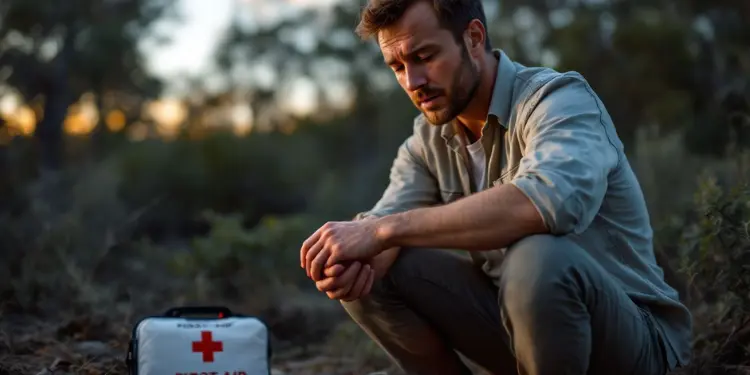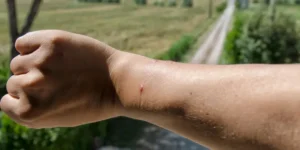Redback spider bites can be frightening. These spiders are widespread in Australia and may cause discomfort. This guide explains redback spider bite first aid. Learn safety measures and quick responses.
Key Takeaways
- Redback spider bites cause severe pain, swelling, and symptoms like nausea and sweating.
- Apply a cold pack to the bite area for up to 20 minutes to reduce pain and swelling.
- Seek medical help if the bite victim is a child, elderly, or has health issues.
- Call 000 for emergencies or the Victorian Poisons Information Centre on 13 11 26 for advice.
- Prevent bites by clearing clutter, sealing cracks, and wearing gloves when working outside.

Symptoms of a Redback Spider Bite

Redback spider bites cause rapid pain and swelling. The bite area becomes red and feels hot. Pain radiates from the bite location and intensifies over time. It can persist for days.
People often experience nausea and vomiting. They might have abdominal pain and excessive sweating. The bite area sweats the most. Lymph glands near the bite become swollen as well.
Systemic symptoms also occur. These include headaches, fatigue, and muscle pain. Some individuals experience neck spasms. Children tend to exhibit more of these systemic symptoms. Within an hour, the skin surrounding the bite may appear red.
The hair in that area might stand up as well. Recognising these symptoms is crucial for prompt action if bitten.
Immediate First Aid Steps
Redback spider bites require prompt action. Here are the key steps to take immediately:
- Position the person lying down and keep them still. This aids in slowing the venom’s spread.
- Reassure the person and inform them that assistance is on its way. Remaining calm can reduce heart rate.
- Monitor the person closely for any changes. Observe for signs such as sweating or vomiting.
- Apply a cold pack to the bite area for up to 20 minutes. This reduces pain and swelling.
- Implement the DRSABCD plan from St John WA. This covers essential first aid steps.
- Assess the person’s condition frequently. Note any new symptoms that develop.
- If possible, keep the bite area below the heart level. This may slow the spread of venom.
- Take off tight clothing or jewellery near the bite. Swelling can make these dangerous.
- Avoid attempting to capture the spider. Concentrate on assisting the person instead.
- Seek help if symptoms worsen. Urgent medical attention may be necessary.
Applying a Cold Compress
Ice packs help ease pain from redback spider bites. Apply a cold pack to the bite area for up to 20 minutes. This cools the area and slows the spread of venom. You can use a bag of frozen peas or a special cold pack from your first aid kit.
Avoid putting ice directly on your skin. Wrap it in a thin cloth first. This prevents the ice from damaging your skin. Take breaks between cold treatments. Allow your skin to warm up for a bit before reapplying the ice.
When to Seek Medical Attention
Medical assistance is essential for certain redback spider bites. Contact emergency services on 000 if the affected person is a child, elderly, or has existing health conditions. Obtain medical advice if pain intensifies or if the individual loses consciousness.
Contact the Victorian Poisons Information Centre on 13 11 26 for information about antivenom. They can provide guidance on the next steps to take.
Seek prompt medical attention if you have concerns. Prioritise safety when dealing with spider bites. The following section will address crucial first aid measures for redback spider bites.
Essential Redback Spider Bite First Aid Guidelines
After understanding when medical assistance is necessary, it’s essential to be aware of the primary first aid steps for redback spider bites. These guidelines can assist in managing pain and minimising risks while awaiting professional care.
- Apply a cold pack to the bite site to reduce pain and swelling
- Administer pain relief medication such as paracetamol at 15 mg per kg of body weight, up to 1 gram
- Use ibuprofen for additional pain relief at 10 mg per kg, up to 400 mg
- Consider oxycodone at 0.1 mg per kg, up to 5 mg, if pain persists
- Obtain 2 vials of redback spider antivenom if required
- Combine antivenom with 100 ml of fluid and administer slowly over 20-30 minutes
- Inject antivenom into a muscle if intravenous access is not possible
- Assess the bite’s improvement after 2 hours
- Consult a poison expert if pain remains constant
- Maintain the bite area clean and dry to prevent infection
Supplementary Information on Redback Spider Bites
Discover more about redback spider bites, including prevention strategies and common misconceptions. There’s a wealth of information to explore!
How to Prevent damage with Redback Spider Bite First Aid
Redback spiders can be a real threat in Australia. Here are some ways to keep these spiders away and stay safe:
- Clear clutter around your home. Redbacks prefer to hide in piles of wood, rocks, or junk.
- Seal cracks in walls and floors. This prevents spiders from entering your house.
- Wear gloves when working outside. Protect your hands when gardening or moving things.
- Check shoes and clothes before use. Redbacks might be inside.
- Keep your lawn short and tidy. Long grass provides spiders places to hide.
- Use sticky traps in dark corners. These can catch spiders early on.
- Check outdoor furniture before sitting. Look under chairs and tables for webs.
- Store firewood away from your house. Stack it off the ground to reduce hiding spots.
- Use screens on windows and doors. This keeps spiders out of your home.
- Clean up spider webs regularly. This makes your home less appealing to redbacks.
- Avoid leaving clothes on the floor. Pick them up to reduce spider hiding spots.
- Keep your home dry. Fix leaky taps and pipes that attract spiders.
- Use natural spider deterrents. Peppermint oil or vinegar can help keep spiders away.
- Educate kids about spider safety. Show them how to spot redbacks and what to do if they see one.
Common Misconceptions about Redback Spider Bite First Aid
Many people assume redback spider bites always result in severe harm. This is incorrect. Most bites only cause mild pain and swelling. Another misconception is that all spider bites lead to skin death.
In reality, necrotising arachnidism is not caused by spider bites at all. Some individuals confuse redback spiders with other species. Cupboard spiders and brown house spiders can cause similar symptoms, but they’re distinct from redbacks.
White-tailed spiders are often accused of causing nasty bites. But these spiders typically only cause local irritation. It’s essential to understand the facts about different spider species.
This helps people remain calm and take appropriate action if they get bitten. Always seek proper medical advice for any concerning spider bite.
Comparison Table: Redback Spider Bite vs. Other Spider Bites
Redback spider bites differ from other spider bites in Australia. Here’s how they compare:
| Feature | Redback Spider Bite | Other Spider Bites |
|---|---|---|
| Pain Level | Severe, lasting pain | Mild to moderate pain |
| Venom Type | Neurotoxic | Varies (some non-toxic) |
| Bite Mark | Often small, hard to see | Can be visible, red mark |
| Symptoms | Sweating, nausea, vomiting | Local swelling, itching |
| Duration | Can last days to weeks | Often resolves in hours |
| First Aid | Cold pack, seek medical help | Clean bite, monitor symptoms |
Redback spiders are the main concern in Victoria. Their bites can cause severe pain and other symptoms. Cupboard or brown house spiders may cause similar symptoms, but less severe. White-tailed spiders might only make the bite area itchy. If you’re unsure about what bit you, consult a doctor. Always prioritise safety and be prepared for spider bite situations.
Resources and Support for Redback Spider Bite First Aid
Help is readily available if you’re bitten by a redback spider. The Victorian Poisons Information Centre provides 24-hour advice on 13 11 26. They can advise on first aid and whether antivenom is necessary.
For severe cases, treatment at a major hospital may be required. PIPER (1300 137 650) can assist with this transfer. These specialists are knowledgeable about spider bites and their treatment.
It’s advisable to have these numbers accessible in case of an emergency. Store them in your phone or note them down in an easily accessible location. Quick action is crucial with spider bites.
Don’t hesitate to seek assistance if you’re concerned. These services are available to support you and ensure your safety.
Conclusion
Proper management of a redback spider bite is crucial for safety. Swift response and appropriate treatment are essential. Remain composed and adhere to first aid procedures. If uncertain, promptly seek medical assistance.
Be prepared and cautious – redback spiders are a common aspect of Australian life.
For more detailed information on managing redback spider bites, please visit our comprehensive guide to Redback Spider Bite First Aid.
FAQs
1. What should I do for Redback Spider Bite First Aid?
Stay calm… it’s key. First, clean the bite area with soap and water. Then, pop on an ice pack to ease the pain. Don’t try to catch the spider – it’s not worth the risk. Ring for help right away, mate. The poison control hotline or emergency services can guide you through the next steps.
2. Are redback spider bites always dangerous?
Not always, but they can be nasty. Most bites cause pain and swelling… some folks might feel crook for a bit. But for little ones, oldies, or people with health worries, it can be more serious. Better safe than sorry – always get it checked out.
3. How can I tell if it’s a redback spider bite?
Look for a red mark where it bit you. You might feel a sharp sting at first. Then, the pain might spread and get worse. Some people sweat a lot or feel sick in the guts. If you spot these signs, don’t muck about – seek help quick smart.
4. Is there an antivenom in Redback Spider Bite First Aid?
Yeah, there is. But not everyone needs it. The doc will decide based on how bad your symptoms are. They might give you pain meds instead. The main thing is to get to a hospital or medical centre sharpish if you’re worried. They’ll sort you out.





